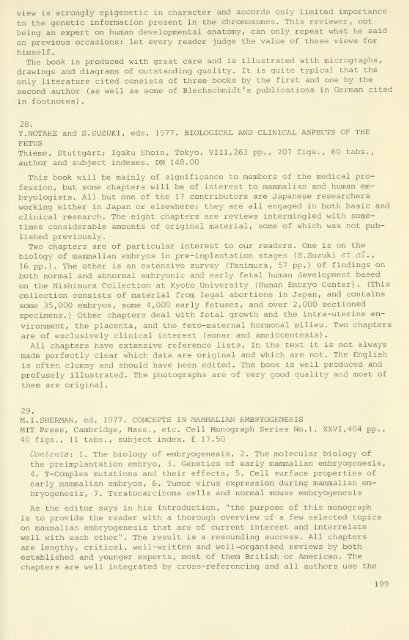General embryological information service - HPS Repository
General embryological information service - HPS Repository
General embryological information service - HPS Repository
You also want an ePaper? Increase the reach of your titles
YUMPU automatically turns print PDFs into web optimized ePapers that Google loves.
.<br />
view is strongly epigenetic in character and accords only limited importance<br />
to the genetic <strong>information</strong> present in the chromosomes. This reviewer, not<br />
being an expert on human developmental anatomy, can only repeat what he said<br />
on previous occasions: let every reader judge the value of these views for<br />
himself.<br />
The book is produced with great care and is illustrated with micrographs,<br />
drawings and diagrams of outstanding quality. It is quite typical that the<br />
only literature cited consists of three books by the first and one by the<br />
second author (as well as some of Blechschmidt ' s publications in German cited<br />
in footnotes)<br />
28.<br />
Y.NOTAKE and S.SUZUKI, eds. 1977. BIOLOGICAL AND CLINICAL ASPECTS OF THE<br />
FETUS<br />
Thieme, Stuttgart; Igaku Shoin, Tokyo. VIII, 263 pp., 207 figs., 50 tabs.,<br />
author and subject indexes. DM 148.00<br />
This book will be mainly of significance to members of the medical profession,<br />
but some chapters will be of interest to mammalian and human embryologists.<br />
All but one of the 17 contributors are Japanese researchers<br />
working either in Japan or elsewhere; they are all engaged in both basic and<br />
clinical research. The eight chapters are reviews intermingled with sometimes<br />
considerable amounts of original material, some of which was not published<br />
previously.<br />
Two chapters are of particular interest to our readers. One is on the<br />
biology of mammalian embryos in pre-implantation stages (S.Suzuki et ai^.,<br />
16 pp.). The other is an extensive survey (Tanimura, 57 pp.) of findings on<br />
both normal and abnormal embryonic and early fetal human development based<br />
on the Nishimura Collection at Kyoto University (Human Embryo Center) . (This<br />
collection consists of material from legal abortions in Japan, and contains<br />
some 35,000 embryos, some 4,000 early fetuses, and over 2,000 sectioned<br />
specimens.) Other chapters deal with fetal growth and the intra-uterine environment,<br />
the placenta, and the feto-maternal hormonal milieu. Two chapters<br />
are of exclusively clinical interest (sonar and amniocentesis)<br />
All chapters have extensive reference lists. In the text it is not always<br />
made perfectly clear which data are original and which are not. The English<br />
is often clumsy and should have been edited. The book is well produced and<br />
profusely illustrated. The photographs are of very good quality and most of<br />
them are original.<br />
29,<br />
M.I.SHERMAN, ed . 1977. CONCEPTS IN MAMMALIAN EMBRYOGENESIS<br />
MIT Press, Cambridge, Mass., etc. Cell Monograph Series No.l. XXVI, 404 pp.,<br />
40 figs., 11 tabs., subject index. E 17.50<br />
Contents: 1. The biology of embryogenesis , 2. The molecular biology of<br />
the preimplantation embryo, 3. Genetics of early mammalian embryogenesis,<br />
4. T-Complex mutations and their effects, 5. Cell surface properties of<br />
early mammalian embryos, 6. Tumor virus expression during mammalian embryogenesis,<br />
7. Teratocarcinoma cells and normal mouse embryogenesis<br />
As the editor says in his Introduction, "the purpose of this monograph<br />
is to provide the reader with a thorough overview of a few selected topics<br />
on manmialian embryogenesis that are of current interest and interrelate<br />
well with each other". The result is a resounding success. All chapters<br />
are lengthy, critical, well-written and well -organised reviews by both<br />
established and younger experts, most of them British or American. The<br />
chapters are well integrated by cross-referencing and all authors use the<br />
.<br />
199
















